Barbell strength training exercises are a fantastic way to lose weight and get in shape.
These exercises not only help build muscle but also boost your metabolism, burn more calories, and improve your overall fitness.
By incorporating barbell squats, deadlifts, bench press, barbell rows, overhead press, and lunges into your routine, you can efficiently burn calories and build muscle.
Focusing on proper form and gradually increasing weight will help you achieve the best results.
Pair these exercises with a balanced diet and regular cardio to maximize your weight loss.
Just a few sessions each week can make a big difference in how you look and feel. So, grab those barbell and let’s get started on your fitness journey.
How Barbell Strength Training Exercises Helps with Weight Loss?
Strength training exercises are an incredibly effective way to lose weight, and here’s why.
As, when you engage in cardio you burn most of the calories when you engage in it. But after you stop cardio exercises your calories stop burning. We can call it shoot-at-sight.
Whereas when you engage in barbell strength training exercises you burn calories after the workout also. Like when you’re watching TV or chilling out on the couch.
Strength training exercises help you to become a calorie-burning machine.
It is because strength training exercises help you to build muscle or muscle mass which is metabolically very active. Eventually, increasing your metabolism.
This means that the more muscle you have, the more calories your body burns, even when you’re just lounging on the couch. It’s like having a higher metabolic rate without doing any extra work.
Another major benefit of barbell strength training is the afterburn effect, scientifically known as excess post-exercise oxygen consumption (EPOC).
After a vigorous barbell workout, your body continues to burn calories at an elevated rate for hours, sometimes even up to 24 hours.
This calorie burn helps in shedding those extra pounds more effectively than traditional cardio exercises.
So, if you’re ready to break those fats and build up a toned physique, let’s dive into some killer barbell strength training exercises. Ready to get started? Let’s begin with the exercises.
Below there are numerous barbell strength training exercises divided into each body parts, the only means to create this list is to find those exercises which fit perfect for you.
Let me explain, each person is different and so talking on that note you must pick only those exercises which help you in better gains.
Let’s take an example, when doing biceps curls, I feel mind muscle connection in the dumbbell curls and my workout buddy feels in the barbell curls.
Try each exercise like this week you perform biceps curls with dumbbells and on next try with barbell and find which helps you in better pump and mind muscle connection.
BEST BARBELL STRENGTH TRAINING EXERCISES
CHEST
1. Incline Barbell Bench Press:
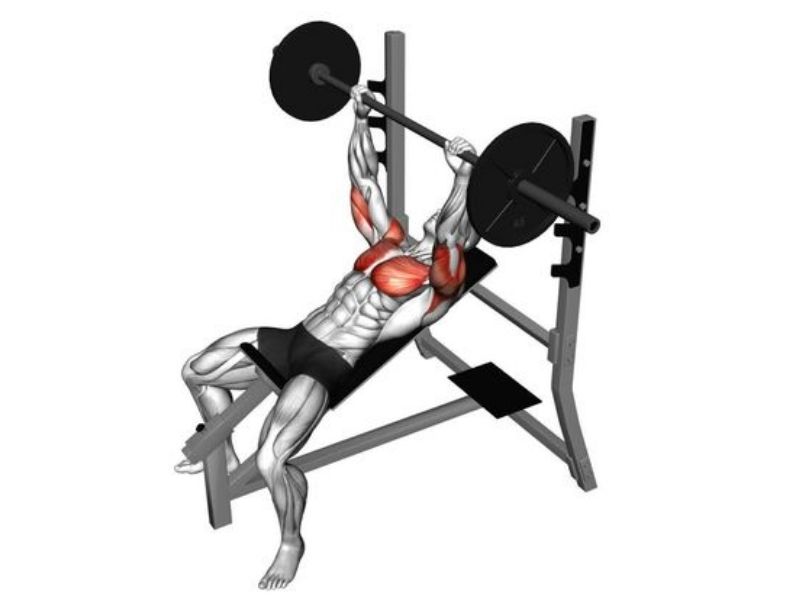
Steps:
- Adjust the bench to an incline of 30-45 degrees.
- Lie down with your back pressed firmly against the pad, feet flat on the floor.
- Grasp the barbell with a shoulder-width grip (hands slightly wider than shoulder width).
- Unrack the barbell and bring it over your chest with your arms extended.
- Lower the bar slowly to your upper chest (near your nipples), feeling a stretch in your pecs.
- Press the bar back up explosively to the starting position.
Common Mistake: Arching your back excessively.
Expert Tip: Maintain a natural arch in your lower back by engaging your core throughout the movement. Imagine pushing your feet into the floor to create a stable base.
2. Barbell Bench Press:

Steps:
- Adjust the bench to a flat position.
- Lie down with your back pressed firmly against the pad, feet flat on the floor.
- Grasp the barbell with a shoulder-width grip (hands slightly wider than shoulder width).
- Unrack the barbell and bring it over your chest with your arms extended.
- Lower the bar slowly to your mid-chest (just below your nipples), feeling a stretch in your pecs.
- Press the bar back up explosively to the starting position.
Common Mistake: Flaring your elbows out excessively.
Expert Tip: Keep your elbows tucked in at a 45-degree angle throughout the movement. This will target your chest muscles more effectively and reduce stress on your shoulders.
3. Barbell Wide-Grip Bench Press:
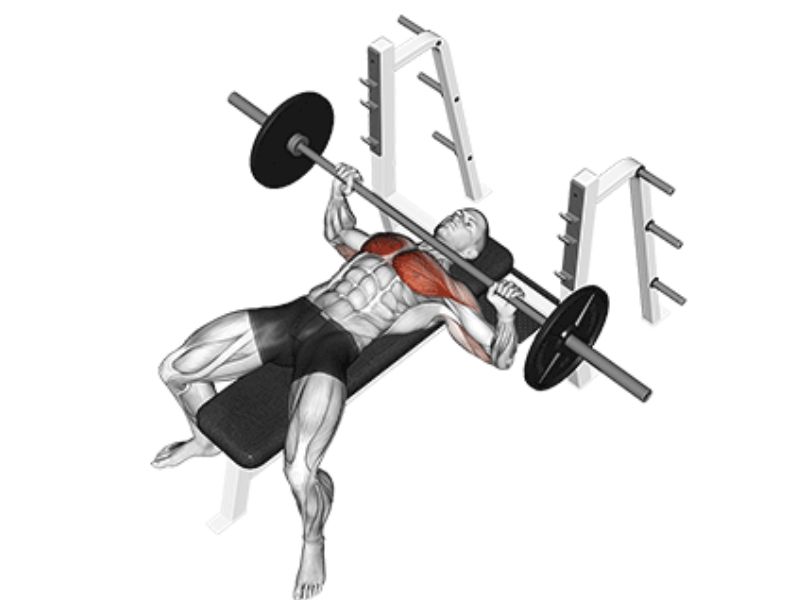
Steps:
- Adjust the bench to a flat position.
- Lie down with your back pressed firmly against the pad, feet flat on the floor.
- Grasp the barbell with a wide grip (hands about 1.5 times shoulder width).
- Unrack the barbell and bring it over your chest with your arms extended.
- Lower the bar slowly to your lower chest (near your sternum), feeling a stretch in your outer pecs.
- Press the bar back up explosively to the starting position.
Common Mistake: Not lowering the bar low enough.
Expert Tip: With a wider grip, you’ll need a deeper chest press to achieve a full range of motion. Focus on feeling a stretch in your outer chest muscles at the bottom of the movement.
4. Decline Barbell Bench Press:
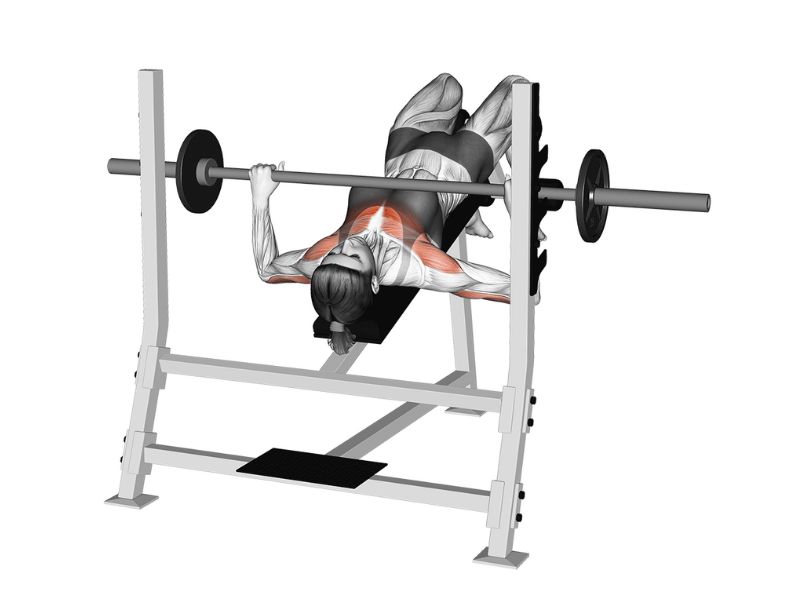
Steps:
- Adjust the bench to a decline of 15-30 degrees.
- Lie down with your back pressed firmly against the pad, feet anchored securely.
- Grasp the barbell with a shoulder-width grip (hands slightly wider than shoulder width).**
- Unrack the barbell and bring it over your lower chest with your arms extended.
- Lower the bar slowly to your lower chest (below your nipples), feeling a stretch in your lower pecs.
- Press the bar back up explosively to the starting position.
Common Mistake: Using too much weight or losing core engagement.
Expert Tip: The decline press is more challenging on your shoulders. Start with a lighter weight and prioritize proper form. Keep your core tight throughout the movement to maintain stability.
BACK
1. Barbell Bent-Over Rows:

Steps:
- Stand with feet shoulder-width apart, knees slightly bent, and core engaged.
- Hinge at your hips, pushing your hips back and keeping your back straight (think about a slight arch in your lower back).
- Grasp the barbell with an overhand grip (slightly wider than shoulder-width).
- Lower the bar towards your shins, keeping it close to your body. Focus on squeezing your shoulder blades together at the bottom of the movement.
- Row the weight back up, bringing your elbows close to your body.
Common Mistake: Rounding your back.
Expert Tip: Maintain a neutral spine throughout the movement. Imagine screwing your shoulder blades back and down as you lower the weight. This keeps your back safe and targets the desired muscles.
2. Barbell T-Bar Rows:
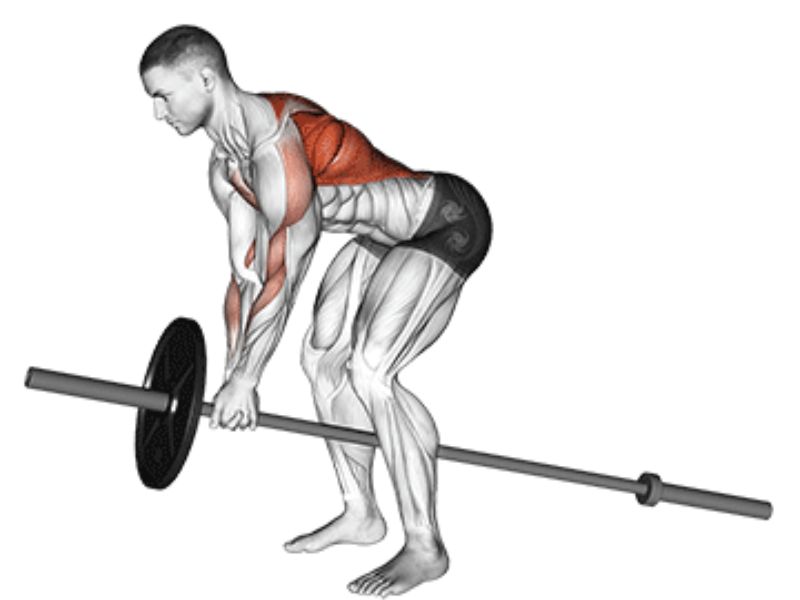
Steps:
- Set the T-bar attachment on a low pulley machine.
- Stand with your feet hip-width apart, knees slightly bent, and core engaged.
- Grasp the T-bar handle with a neutral grip (palms facing each other).
- Lean forward slightly, keeping your back straight, and core engaged.
- Pull the handle towards your torso, squeezing your shoulder blades together.
Common Mistake: Leaning too far forward or using momentum.
Expert Tip: Maintain a controlled movement. Focus on pulling the weight with your back muscles, not by swinging your body. Keep your core tight to prevent your lower back from arching.
3. Romanian Deadlift:
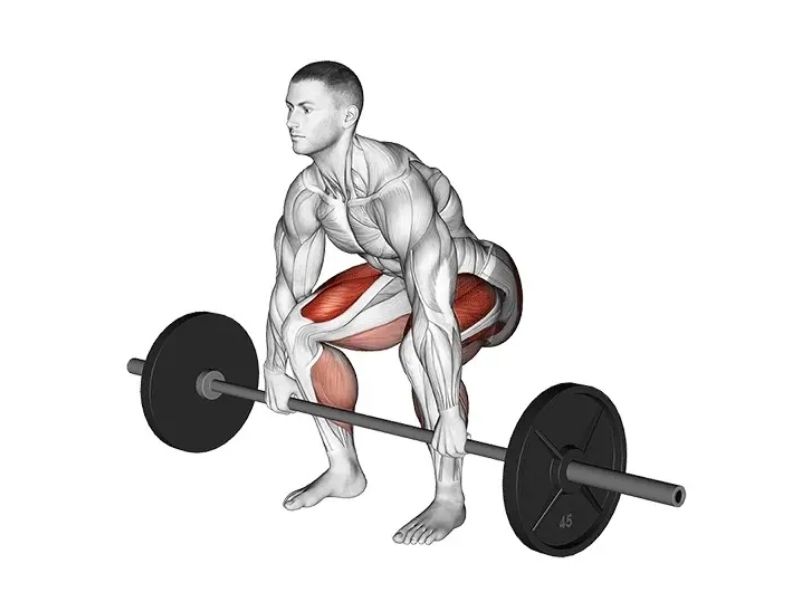
Steps:
- Stand with feet shoulder-width apart, core engaged, and a barbell held in front of your thighs (almost touching your shins).
- Hinge at your hips, pushing your hips back and lowering the barbell down your legs while keeping your back straight (slight arch in lower back).
- Lower the bar until you feel a stretch in your hamstrings, then return to the starting position by squeezing your glutes and hamstrings.
Common Mistake: Rounding your back or bending your knees too much.
Expert Tip: Focus on hinging at the hips, not squatting down. Keep your core tight and back straight throughout the movement. This exercise primarily targets your hamstrings and glutes, but it also engages your lower back muscles.
4. Barbell Hyperextensions (Advanced):
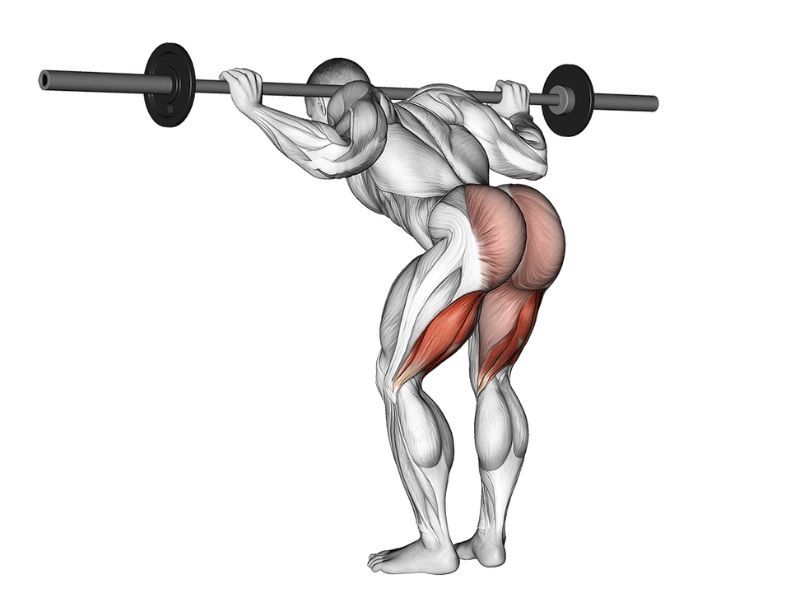
Steps:
- Set up a hyperextension machine with a pad for your thighs and another pad for your chest.
- Secure your legs under the thigh pad and lean forward from the hips, keeping your back straight (slight arch in lower back).
- Lower your torso down until you feel a stretch in your lower back, then contract your lower back muscles to return to the starting position.
Common Mistake: Going too low or using excessive weight.
Expert Tip: This exercise is advanced and can put stress on your lower back. Start with a light weight and focus on controlled movements. Only lower yourself down as far as you can comfortably maintain a flat back.
5. Wide-Grip Barbell Row:
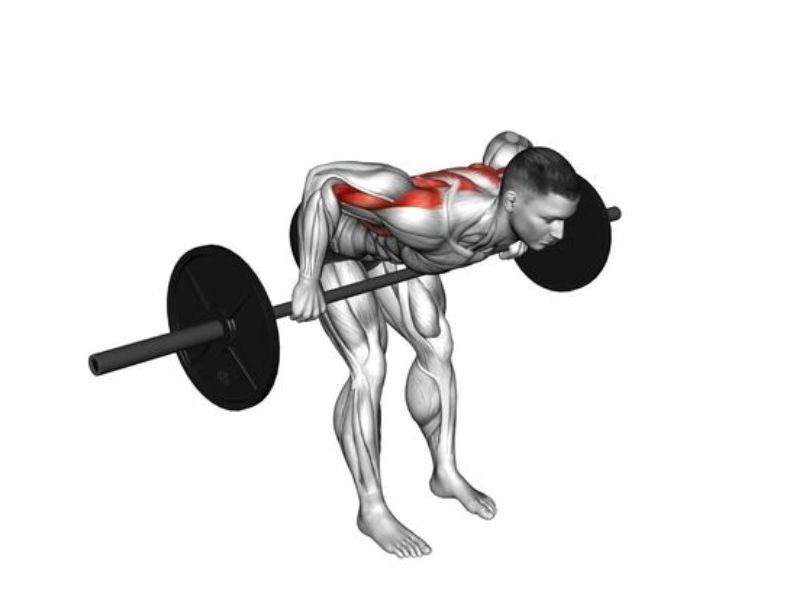
Steps:
- Stand with feet shoulder-width apart, knees slightly bent, and core engaged.
- Hinge at your hips, pushing your hips back and keeping your back straight (think about a slight arch in your lower back).
- Grasp the barbell with a wide grip (hands significantly wider than shoulder-width).
- Lower the bar towards your lower abdomen, keeping it close to your body. Focus on squeezing your shoulder blades together at the bottom of the movement.
- Row the weight back up, bringing your elbows close to your body.
Common Mistake: Not engaging your lats or letting your shoulders round forward.
Expert Tip: A wider grip emphasizes your lats (the muscles on the sides of your back). Focus on pulling with your elbows, not your biceps. Keep your chest up and shoulders down throughout the movement.
SHOULDER
1. Barbell Front Raise:
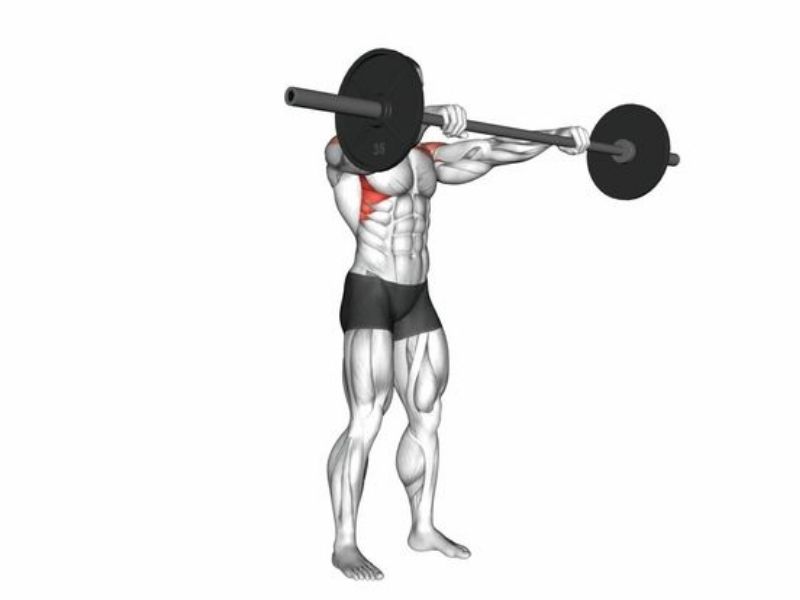
Steps:
- Stand tall with feet shoulder-width apart, core engaged, and a barbell held in front of your thighs (palms facing forward).
- Raise the barbell straight up in front of your body, keeping your elbows slightly bent and arms close to your body. Lift only until your arms are parallel to the floor (fists at shoulder height).
- Slowly lower the barbell back down to the starting position.
Common Mistake: Swinging the weight or using momentum.
Expert Tip: Focus on using your front delt muscles (shoulders) to lift the weight. Keep your core tight and avoid arching your back. This exercise primarily targets the front of your shoulders.
2. Barbell Shoulder Press:
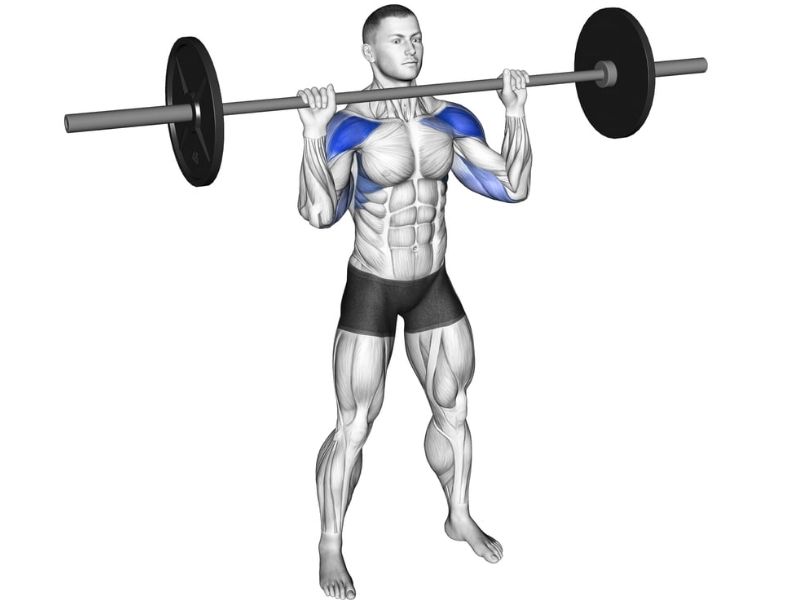
Steps:
- Stand tall with feet shoulder-width apart, core engaged, and a barbell held at shoulder level (palms facing forward).
- Press the barbell straight overhead until your arms are extended. Keep your elbows slightly tucked in and core tight.
- Lower the barbell back down to shoulder level with control.
Common Mistake: Arching your back or leaning forward.
Expert Tip: Maintain a neutral spine throughout the movement. Imagine pressing the ceiling up with your palms. Keep your core engaged for stability and avoid using momentum to lift the weight.
3. Barbell Upright Row:

Steps:
- Stand tall with feet shoulder-width apart, core engaged, and a barbell held in front of your thighs (palms facing your body).
- Raise the barbell up towards your chin, keeping your elbows close to your body and forearms parallel to the floor. Lift only until your elbows reach shoulder height.
- Slowly lower the barbell back down to the starting position.
Common Mistake: Using too much weight or letting your elbows flare out to the sides.
Expert Tip: This exercise can put stress on your shoulders. Use a very light weight and prioritize proper form over lifting heavy. Keep your elbows tucked in and core tight throughout the movement.
4. Barbell Behind-the-Neck Press:
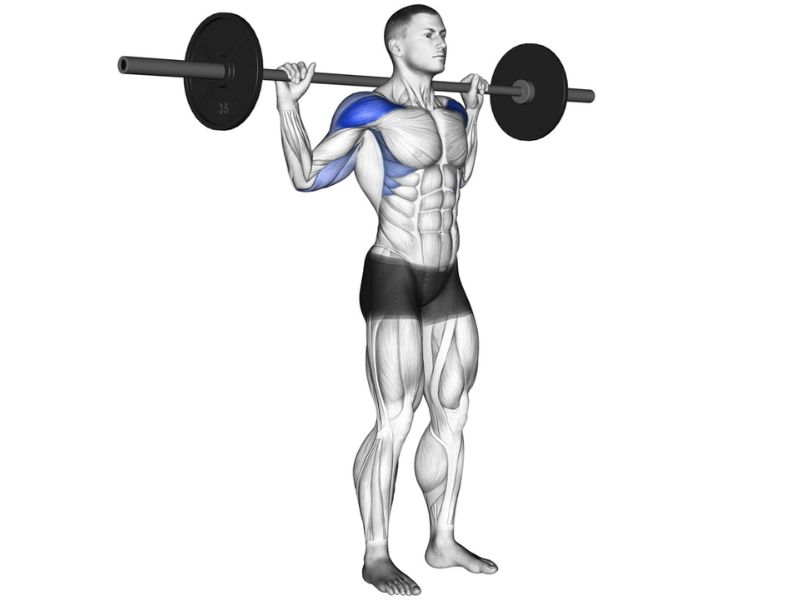
Steps:
- Stand tall with feet shoulder-width apart, core engaged, and a barbell held behind your head (palms facing forward). (Caution: This is an advanced exercise and can be risky for beginners due to potential shoulder impingement)
- Press the barbell straight overhead until your arms are extended. Keep your elbows slightly tucked in and core tight.
- Lower the barbell back down behind your head with control.
Common Mistake: This exercise is generally not recommended, especially for beginners, due to the potential for shoulder impingement.
Expert Tip: There are safer and more effective alternatives for shoulder pressing. Consider sticking with the Barbell Shoulder Press explained earlier.
5. Barbell Shrugs:
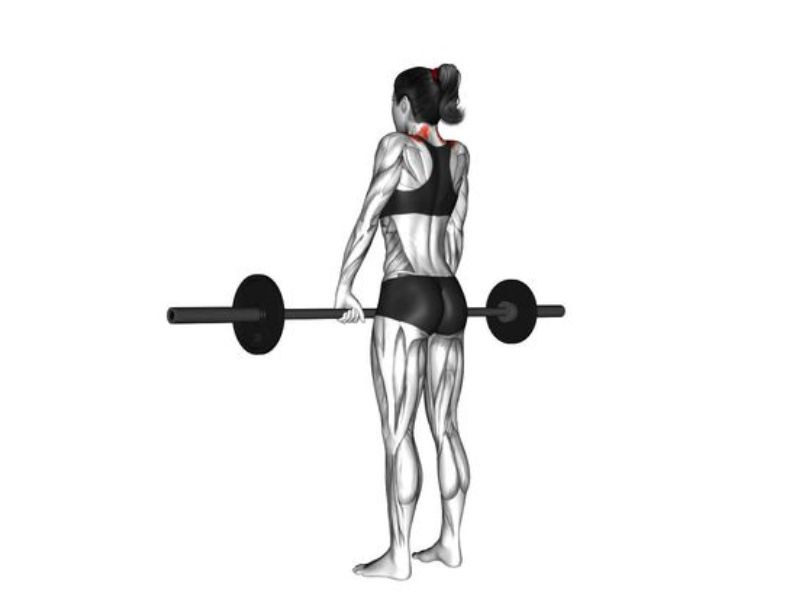
Steps:
- Stand tall with feet shoulder-width apart, core engaged, and a barbell held in front of your thighs (palms facing your body).
- Shrug your shoulders upwards, bringing them towards your ears. Hold for a second, then slowly lower them back down.
Common Mistake: Lifting your shoulders while arching your back or using momentum.
Expert Tip: Focus on isolating the shrug movement. Keep your core tight, back straight, and avoid using your arms or legs to lift the weight.
LEGS
1. Barbell Stiff-Leg Deadlifts:
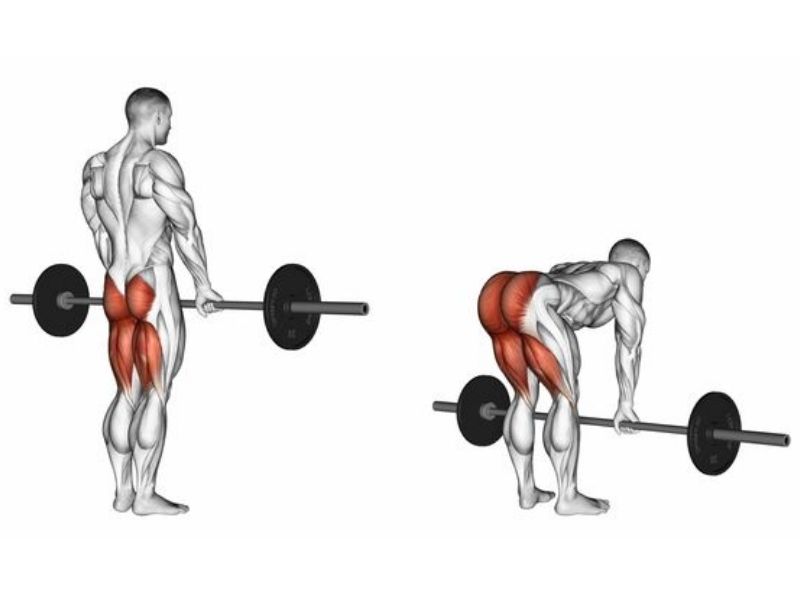
Steps:
- Stand with feet shoulder-width apart, core engaged, and a barbell held in front of your thighs (almost touching your shins).
- Hinge at your hips, pushing your hips back and keeping your back straight (slight arch in lower back). Lower the barbell down your legs, keeping your knees slightly bent throughout the movement. Feel a stretch in your hamstrings as you lower the weight.
- Stop when you feel a stretch in your hamstrings or your back begins to round. Squeeze your glutes and hamstrings to return to the starting position.
Common Mistake: Rounding your back or bending your knees too much.
Expert Tip: Focus on hinging at the hips, keeping your core tight and back straight. This exercise primarily targets your hamstrings and glutes, but it also challenges your lower back muscles. Don’t go too low if you can’t maintain proper form.
2. Barbell Hip Thrusts:
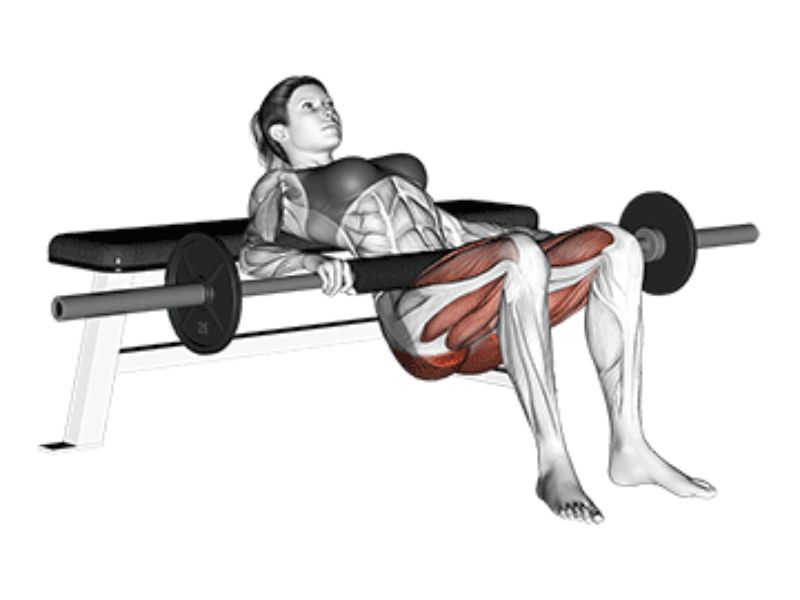
Steps:
- Sit on the floor with your back against a bench, knees bent and feet flat on the floor. The barbell should be resting across your hips.
- Engage your core and glutes, then press your heels into the floor to lift your hips off the ground until your body forms a straight line from your shoulders to your knees.
- Squeeze your glutes at the top, then slowly lower your hips back down to the starting position.
Common Mistake: Arching your back or using momentum.
Expert Tip: Keep your core engaged and back pressed into the bench throughout the movement. Focus on squeezing your glutes to lift your hips, not using your lower back.
3. Barbell Glute Bridges:
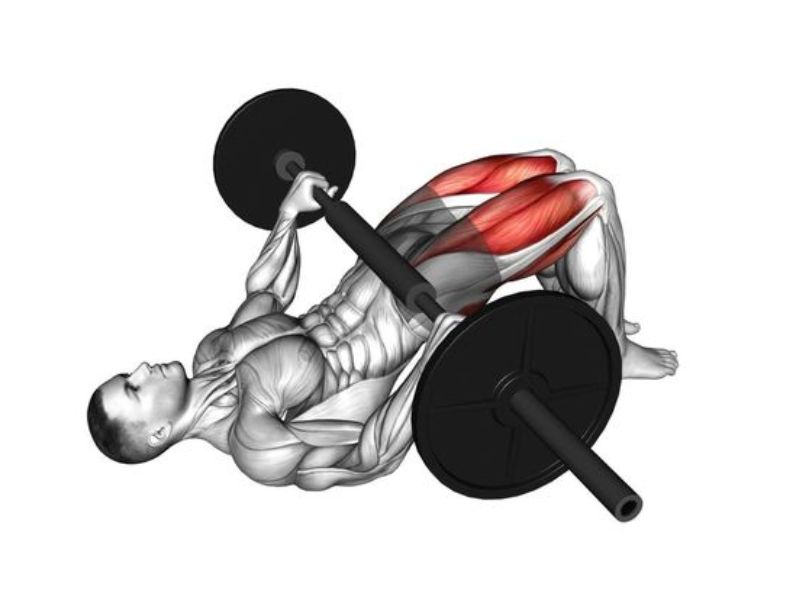
Steps:
- Lie flat on your back with your knees bent and feet flat on the floor. The barbell should be resting across your hips.
- Engage your core and glutes, then press your heels into the floor to lift your hips off the ground until your body forms a straight line from your shoulders to your knees.
- Squeeze your glutes at the top, then slowly lower your hips back down to the starting position.
Common Mistake: Arching your back or using your hamstrings more than your glutes.
Expert Tip: Similar to hip thrusts, keep your core tight and back flat on the ground. Focus on initiating the movement with your glutes, not your hamstrings.
4. Barbell Squats (The King):
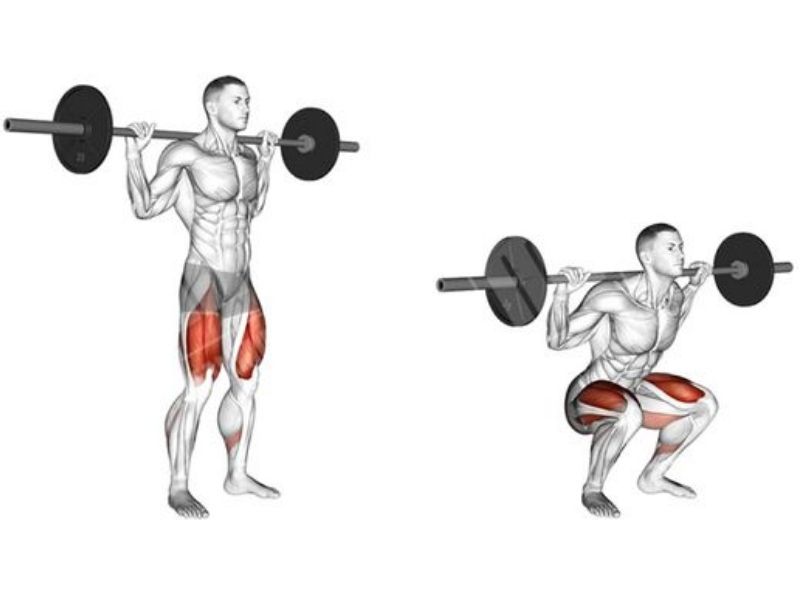
Steps:
- Stand with feet shoulder-width apart, toes slightly pointed outward, core engaged, and a barbell held across your upper back (low bar squat) or at shoulder level (high bar squat).
- Squat down as if you’re going to sit in a chair, keeping your back straight (slight arch in lower back) and knees tracking in line with your toes. Lower yourself until your thighs are parallel to the floor (or as low as your flexibility allows with proper form).
- Push through your heels to return to the starting position.
Common Mistake: Depth – not squatting low enough, letting your knees cave in, or arching your back excessively.
Expert Tip: Squat to a depth where your hips are at least parallel to the floor, but only if you can maintain proper form. Keep your core tight, back straight, and knees tracking outwards. Start with a lighter weight and focus on controlled movements.
5. Barbell Lunges:
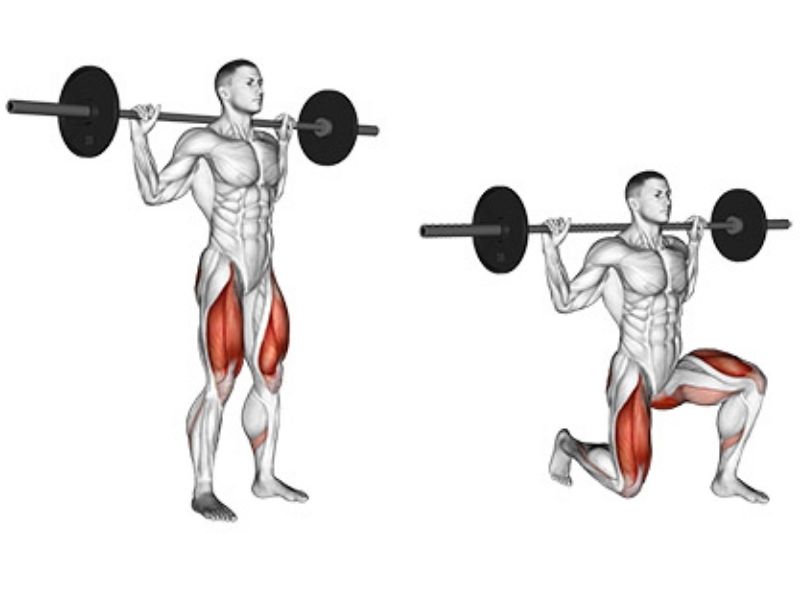
Steps:
- Stand with feet hip-width apart, core engaged, and a barbell held across your upper back (low bar) or at shoulder level (high bar).
- Take a large step forward with one leg, lowering your hips until both knees are bent at 90-degree angles. Your front knee should not track past your toes.
- Push through your front heel to return to the starting position. Repeat with the other leg.
Common Mistake: Lunging too far forward or letting your front knee cave in.
Expert Tip: Focus on keeping your torso upright and core engaged throughout the movement. Your front knee should track over your ankle, not caving inward. Start with a lighter weight and focus on proper form before increasing weight.
6. Barbell Bulgarian Split Squats:
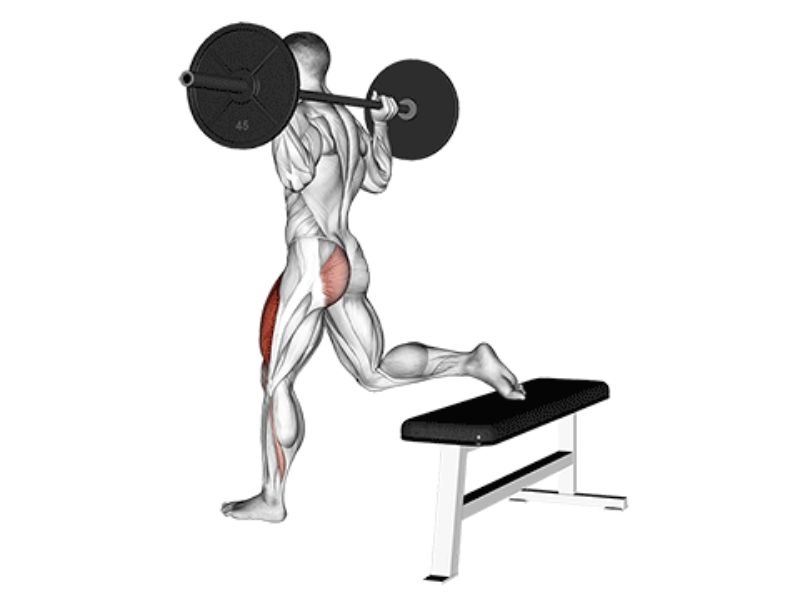
Steps:
- Stand with one foot elevated on a bench behind you, core engaged, and a barbell held across your upper back (low bar) or at shoulder level (high bar).
- Lower your body down by bending your standing leg, keeping your back straight and front knee tracking in line with your toes. Descend until your front thigh is nearly parallel to the floor.
- Push through your heel to return to the starting position. Repeat with the other leg.
Common Mistake: Losing balance or letting your front knee cave in.
Expert Tip: This exercise challenges your balance and stability. Start by performing bodyweight squats with one leg elevated before adding weight. Focus on keeping your core tight, back straight, and front knee tracking outwards.
BICEPS
1. Standing Barbell Curl (The Classic):
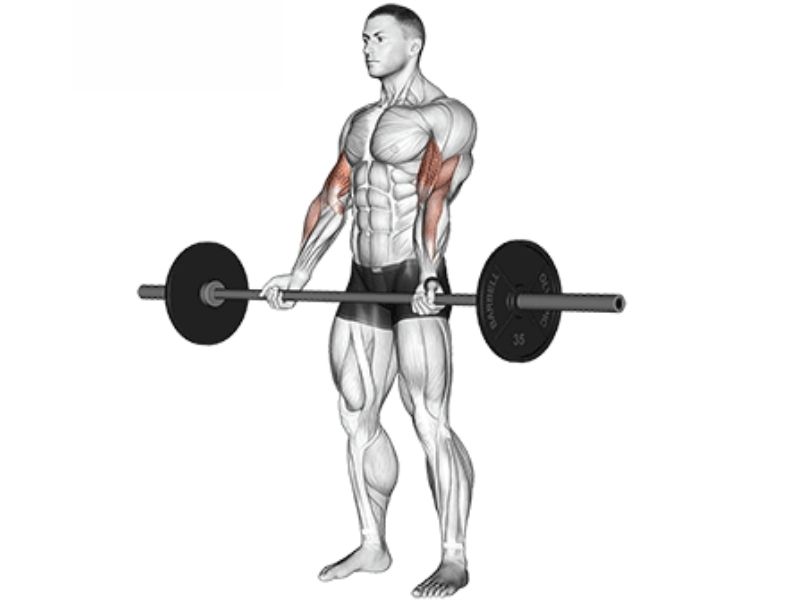
Steps:
- Stand tall with feet shoulder-width apart, core engaged, and a barbell held in front of your thighs with palms facing forward.
- Curl the barbell up towards your shoulders, keeping your elbows close to your sides throughout the movement. Squeeze your biceps at the top, then slowly lower the barbell back down to the starting position.
Common Mistake: Using momentum or swinging the weight. Leaning back excessively can also occur.
Expert Tip: This is a foundational bicep exercise. Focus on using your biceps to lift the weight, not your back or shoulders. Keep your core tight and avoid leaning back to compensate for the weight.
2. Spider Barbell Curls:
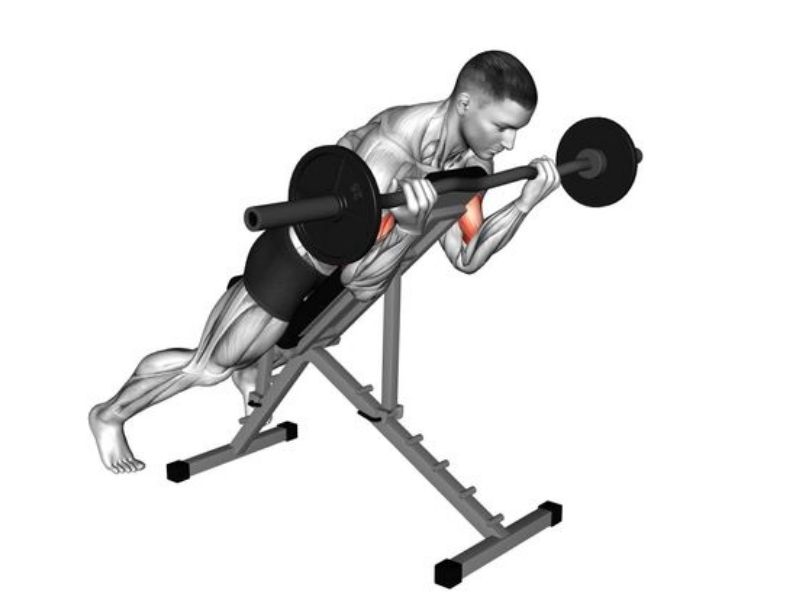
Steps:
- Set up an incline bench with a backrest angled at about 45 degrees. Lie on your stomach with your chest resting on the pad and core engaged.
- Hold a barbell with an underhand grip (palms facing down) and arms hanging straight down towards the floor.
- Curl the barbell up towards your chest, keeping your elbows close to your body throughout the movement. Squeeze your biceps at the top, then slowly lower the barbell back down to the starting position.
Common Mistake: Arching your back or using momentum.
Expert Tip: This exercise requires good core stability and can be challenging for beginners. Consider starting with regular barbell curls before progressing to Spider Curls.
3. Preacher Barbell Curl (Targeted Isolation):
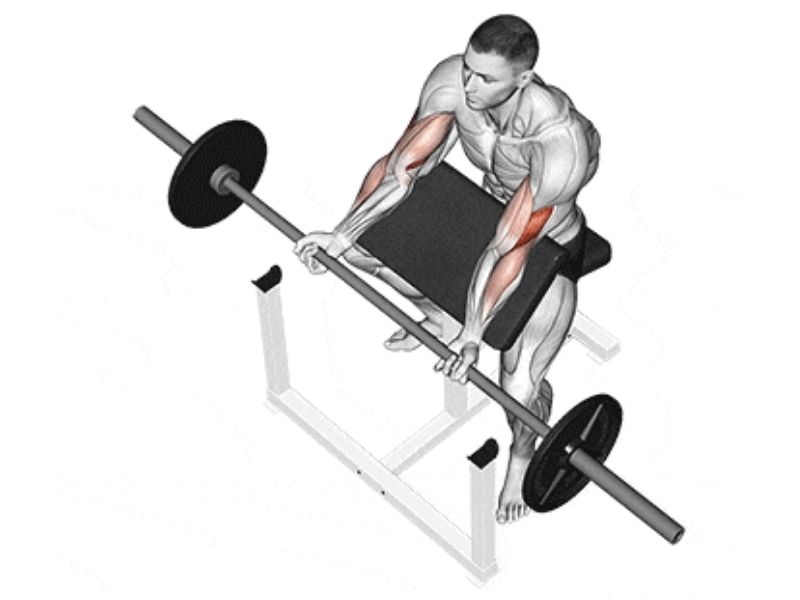
Steps:
- Set up a preacher curl machine with a pad to support your upper arms. Sit on the seat and adjust the pad height so it rests just below your armpits.
- Hold a barbell with an underhand grip (palms facing down) and rest your upper arms on the pad.
- Curl the barbell up towards your chest, keeping your elbows secured on the pad throughout the movement. Squeeze your biceps at the top, then slowly lower the barbell back down to the starting position.
Common Mistake: Not keeping your upper arms locked on the pad or using momentum.
Expert Tip: This exercise isolates the bicep brachii muscle by minimizing arm movement. Maintain proper form and avoid using momentum to lift the weight.
4. Barbell Drag Curl:
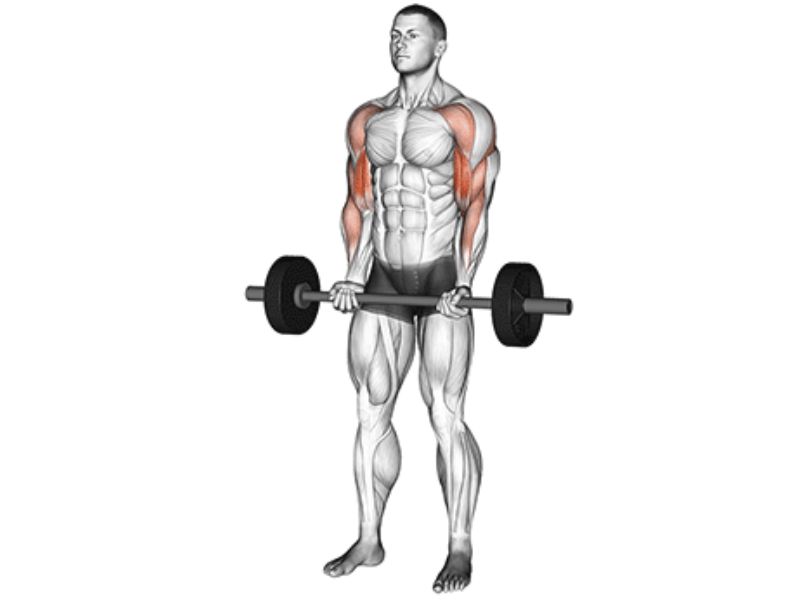
Steps:
- Stand tall with feet shoulder-width apart, core engaged, and a barbell held in front of your thighs with palms facing down.
- Keep your back straight and core tight. Drag the barbell straight up your body, grazing your shins and thighs as you lift. Focus on using your biceps to pull the weight up.
- Curl the barbell up towards your shoulders at the top of the movement, then slowly lower it back down along your body, following the same path.
Common Mistake: Rounding your back or using momentum.
Expert Tip: This exercise combines a bicep curl with a pulling motion. Keep your core tight and back straight throughout the movement. Focus on using your biceps to drag and curl the weight.
TRICEPS
1. Barbell Overhead Tricep Extension (The King):
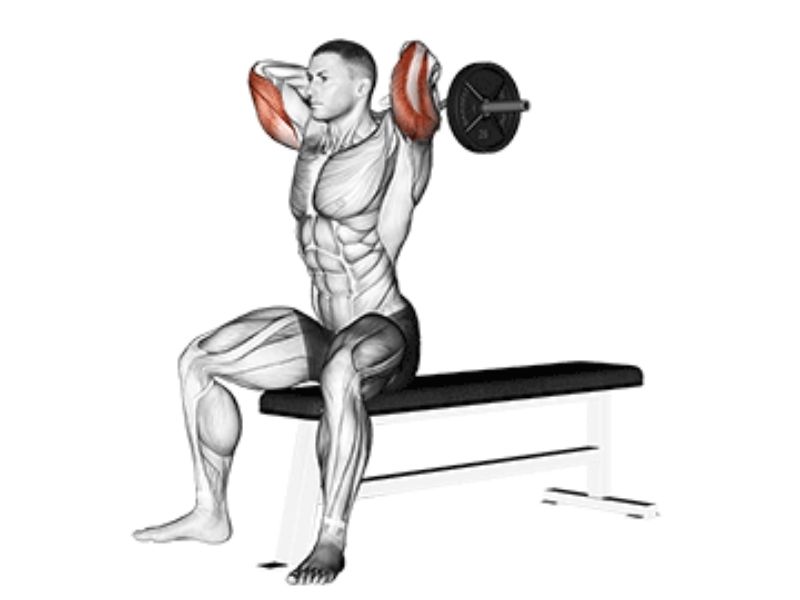
Steps:
- Stand tall with feet shoulder-width apart, core engaged, and a barbell held overhead with your arms straight (palms facing forward).
- Lower the barbell down behind your head until your elbows are bent at a 90-degree angle. Keep your upper arms close to your head throughout the movement.
- Squeeze your triceps to push the barbell back up to the starting position.
Common Mistake: Flaring your elbows out to the sides or arching your back.
Expert Tip: This is a fundamental tricep exercise. Keep your elbows tucked in close to your head for proper isolation. Maintain a neutral spine and avoid arching your back to compensate for the weight.
2. Barbell Skull Crushers:
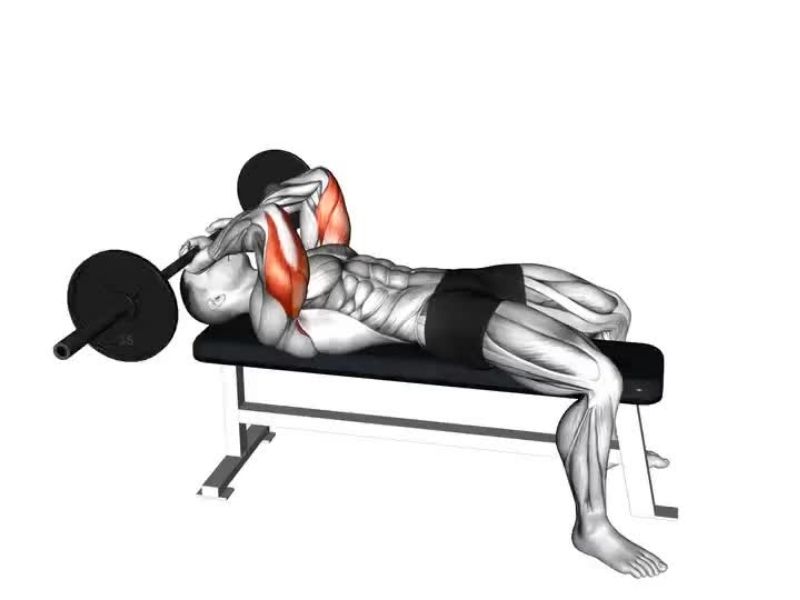
Steps:
- Lie flat on a bench with your back pressed against the pad, core engaged, and a barbell held overhead with your arms straight (palms facing forward). (Caution: This exercise can put stress on your elbows. Use lighter weight and prioritize proper form over heavy lifting)
- Lower the barbell down towards your forehead until your elbows are bent at a 90-degree angle. Keep your upper arms close to your head throughout the movement.
- Squeeze your triceps to push the barbell back up to the starting position.
Expert Tip: This exercise can be risky for some due to potential elbow strain. Beginners should opt for safer alternatives like Overhead Tricep Extensions or Close-Grip Bench Press (explained below).
3. Barbell Close-Grip Bench Press:

Steps:
- Lie flat on a bench with your back pressed against the pad, core engaged, and a barbell held at chest level with a narrow grip (hands closer together than shoulder-width apart).
- Lower the barbell down to your chest, keeping your elbows tucked in at a 45-degree angle.
- Squeeze your triceps to push the barbell back up to the starting position.
Common Mistake: Using a grip that’s too wide or flaring your elbows out to the sides.
Expert Tip: This exercise is a great alternative to Skull Crushers for beginners. The closer grip targets your triceps more effectively. Keep your elbows tucked in and focus on pushing the weight with your triceps.
4. Swiss Bar Tricep Extension:
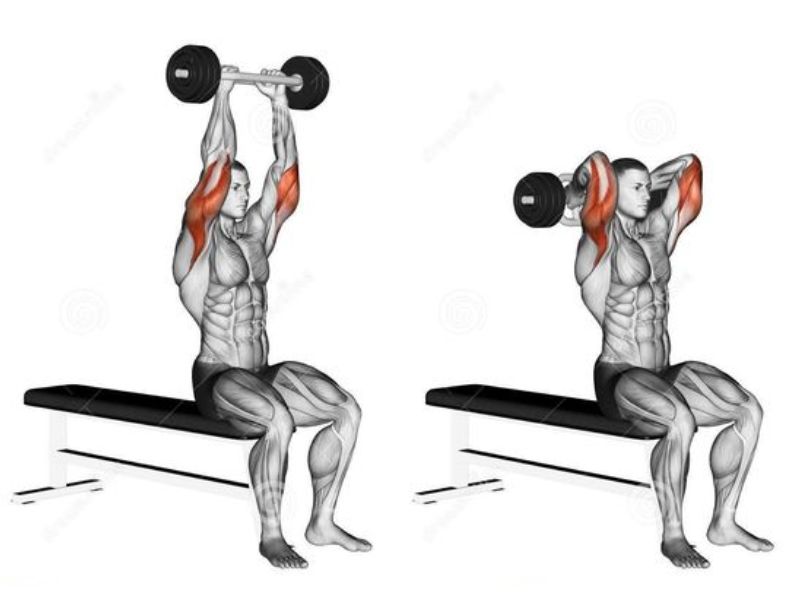
Steps:
- Stand tall with feet shoulder-width apart, core engaged, and a Swiss bar held overhead with your arms straight (neutral grip, palms facing each other).
- Lower the bar down behind your head until your elbows are bent at a 90-degree angle. Keep your upper arms close to your head throughout the movement.
- Squeeze your triceps to push the bar back up to the starting position.
Common Mistake: Leaning forward or arching your back.
Expert Tip: The Swiss bar allows for a more natural hand position, reducing wrist strain. Keep your core tight and back straight throughout the movement.
5. Barbell JM Press:
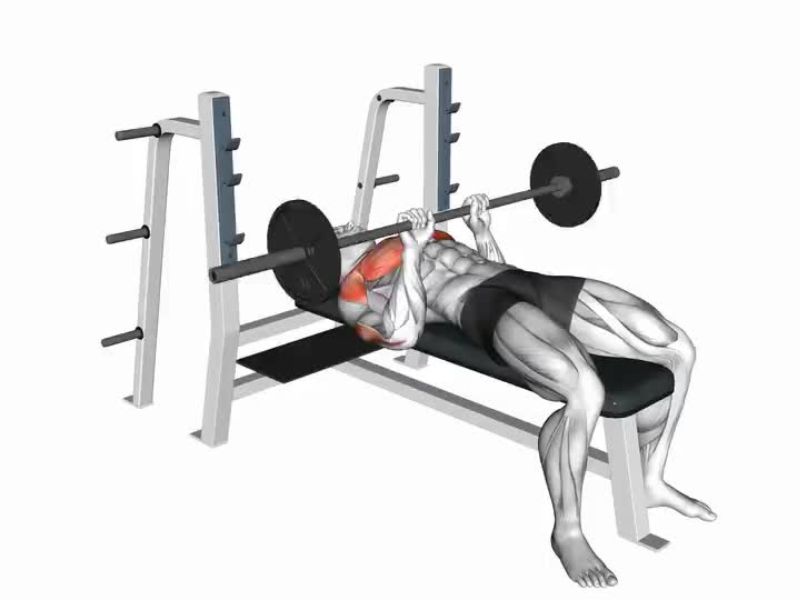
Steps:
- Place the barbell on a squat rack at a height where you can comfortably grab it with an overhand grip (palms facing away) just wider than shoulder-width apart.
- Stand with your feet shoulder-width apart, core engaged, and back straight.
- Keeping your elbows tucked in close to your body, slowly lower the barbell straight down towards your forehead.
- Imagine your elbows tracing a straight line down as you move.
- Descend until the bar is just above your forehead or touches your brow lightly.
- Engage your triceps to press the barbell back up to the starting position directly over your shoulders.
- Focus on controlled movement and maintain a straight core throughout the press.
Common Mistake: Leaning too far forward or losing core engagement.
Expert Tip: This exercise is advanced and requires good core stability. Maintain a controlled movement and prioritize proper form over heavy weight. Beginners should focus on mastering the exercises mentioned above before progressing to the JM Press.
What are some common mistakes to avoid when using Barbell Strength Training Exercises?
Barbell strength training exercises can be a game-changer for building muscle and losing weight, but only if you do it right. Whether you’re new to the gym or a seasoned lifter, avoiding these common mistakes will help you get the most out of your workouts and keep your injury-free. Let’s get in.
A. Improper Form and Technique

Entering the gym and seeing peers lifting heavy weights can trigger the urge to push oneself to lift heavier weights as well.
This is often driven by ego and can lead to neglecting proper form and technique, a practice commonly known as ego-lifting.
Lifting heavy weights without proper form is essentially an attempt to show off rather than train effectively.
Neglecting proper form and technique not only diminishes the effectiveness of your workouts but also significantly increases the risk of injury, potentially sidelining you for months or even years.
Proper form and technique are crucial not just for preventing injuries but also for achieving better gains.
To ensure you maintain proper form, choose weights that allow you to complete 10–12 reps with controlled and precise movements.
A useful tip is to focus on higher reps with lower weights, as this empowers you to control the weights rather than letting the weights control you.
Don’t forget to gradually increase the weight while maintaining correct form, especially when performing barbell strength training exercises. This approach ensures steady progress and minimizes the risk of injury.
B. Neglecting Warm-Up and Cool-Down

When at rest, blood pressure in your muscles is relatively low. However, engaging in strength training exercises, including barbell strength training exercises, causes a significant spike in blood pressure, which can pose a risk of serious injury if not managed properly.
Therefore, it’s crucial to perform a light cardio warm-up to prepare your body for the workout session. This helps increase blood flow to your muscles, reducing the risk of injury by ensuring they are adequately supplied with oxygen and nutrients.
Similarly, the cool-down phase is equally important. During a workout, both your heart rate and blood flow increase significantly.
A proper cool-down helps your heart rate and breathing return to their resting levels and promotes the removal of metabolic waste products from the muscles, preventing blood from pooling in the extremities.
Incorporating stretching into your cool-down routine enhances flexibility by elongating the muscles that may have contracted during exercise. This can reduce muscle stiffness and soreness, enhance range of motion, and improve overall muscle function.
By prioritizing proper warm-up and cool-down routines, especially when engaging in barbell strength training exercises, you can enhance your performance and safeguard your body against potential injuries.
Conclusion
Barbell strength training exercises is an excellent way to lose weight and get fit. These exercises help build muscle, boost your metabolism, and burn more calories. They also improve your overall fitness and make you feel great.
Incorporating barbell strength training exercises like squats, deadlifts, bench press, barbell rows, overhead press, and lunges into your workout routine can efficiently burn calories and build muscle. Focusing on proper form and gradually increasing weight will give you the best results.
Pair these exercises with a balanced diet and regular cardio to maximize your weight loss. Just a few sessions each week can make a big difference in how you look and feel. So, grab those barbells and let’s start your fitness journey together.

